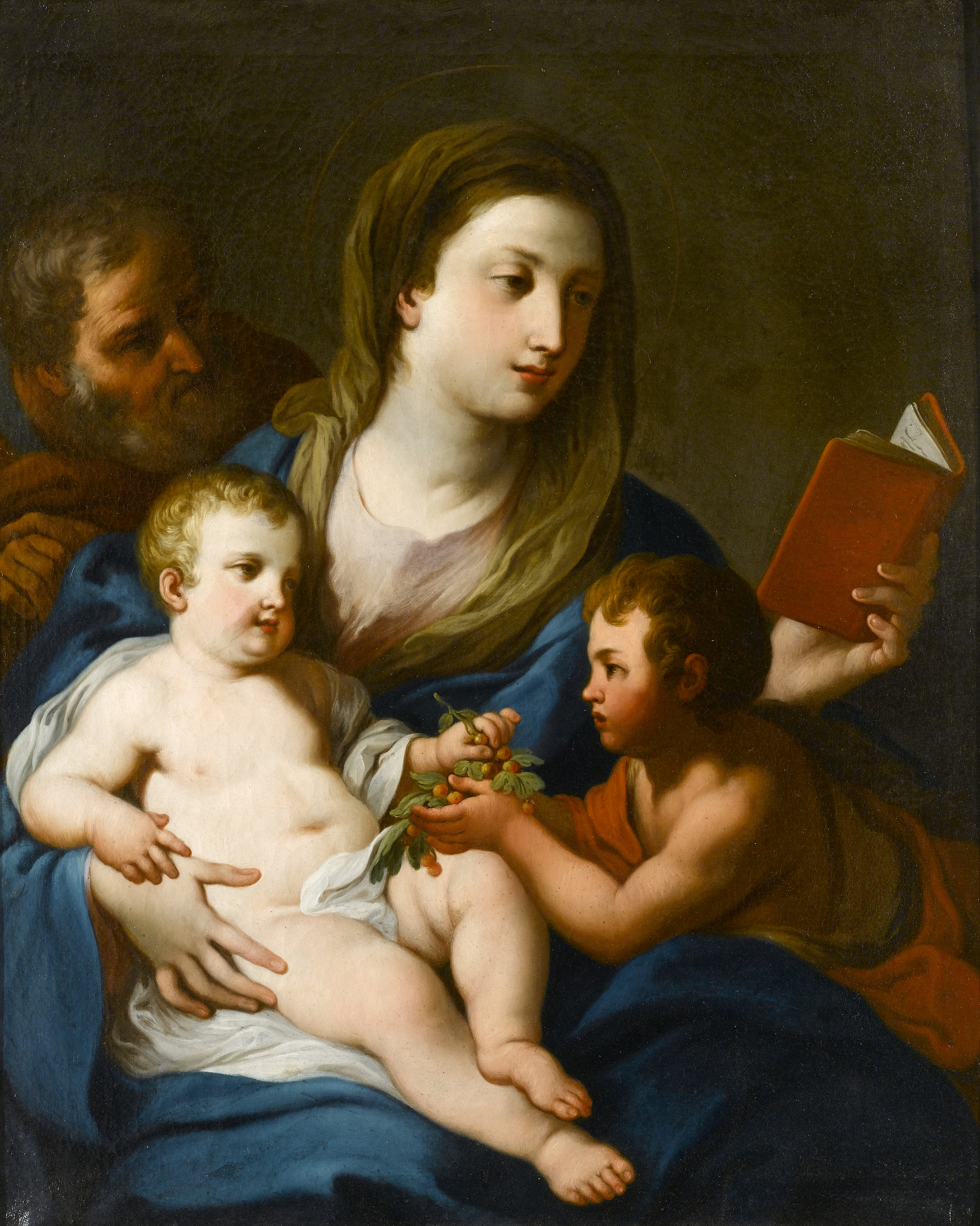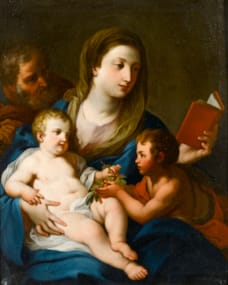
ebastiano Conca
(Gaeta 1680 - Naples 1764)
 Biography
Biography The Holy Family with the Infant Saint John the Baptist
Biography
He was the son of Erasmo Conca and Caterina de Iorio and the eldest of ten children. According to Francesco Maria Niccolò Gabburri, when very young he was a pupil of Luca Giordano, but the only teacher who can be assigned to him with certainty is Francesco Solimena. Conca probably entered his studio in Naples c. 1693 and in 1703 assisted him in painting decorative frescoes for the abbey of Montecassino. In 1706 (de Dominici) or perhaps 1707 (Pio) Conca moved to Rome. He remained there for 45 years but never lost touch with Gaeta, to which he often returned. In Rome, inspired by the art of Michelangelo, Raphael and the Carracci, he moved away from Solimena and developed a greater classicism, indebted to Carlo Maratti. Works dating from his first ten years in Rome include the Adoration of the Magi (1707; Tours, Musee Beaux-Arts), the Allegory of Painting, the Allegory of Music (both Rome, Galleria Spada) and a St Bartholomew (untraced).
The last-named work was commissioned for his own collection by Cardinal Pietro Ottoboni, who was also the patron of Francesco Trevisani; Conca’s spontaneous and lyrical style attracted intellectuals like Ottoboni, whose taste was influenced by the Society of Arcadia. Through Ottoboni, Conca won the favour of the Roman Curia. Cardinal Tommaso Maria Ferrari (1647–1716) commissioned altarpieces of the Vision of St Dominic (1714) and Scenes from the Life of St Dominic (1715) for the church of S Clemente, Rome. Pope Clement XI assigned to him a fresco of the Miracle of St Clement, one of a series of frescoes of the saint’s life above the nave arcade in the same church, and an oval medallion of Jeremiah (1718) in S Giovanni Laterano, Rome. This led to a commission for the decoration of the Palazzo de Carolis, Rome, where he worked with the foremost artists of the time. In 1719 he made a pilgrimage to Montecassino.
For the Piedmontese royal house of Savoy, through the offices of Filippo Juvarra, who had been architect and scenographer to Cardinal Ottoboni, Conca executed paintings for the royal hunting lodge, the Venaria Reale (1721–4), for the church of the Superga (1726) and for the Palazzo Reale, Turin. Between 1721 and 1724 he frescoed the vault of S Cecilia in Trastevere, Rome, with the Coronation of St Cecilia. This important commission was procured for him by Cardinal Francesco Acquaviva d’Aragona (1665–1725), the Spanish ambassador, who sent the cartoons to Queen Elizabeth of Spain, and the modello to her uncle, Francis, Duke of Parma. In this large composition Conca toned down the magniloquent exuberance of the Baroque and created a lighter and more balanced composition that is fully Rococo in spirit.
In 1725 the Duke of Parma, impressed with Conca’s talent, gave him a studio in the Palazzo Farnese, Rome, and there Conca established his Accademia del Nudo which, since c. 1710, had attracted many followers, from as far afield as France, Germany and Spain. Among the most outstanding of the pupils who attended the academy were Pompeo Girolamo Batoni, Corrado Giaquinto and Anton Raphael Mengs. Several printmakers also worked within the academy, including the Swiss Johann Jakob I Frey and the better-known Giuseppe Vasi (later Piranesi’s teacher). Through their engravings these artists helped to publicize and spread Conca’s style. Through the offices of Cardinal Marco Cornelio Bentivoglio d’Aragona (1668–1732) Conca won the patronage of the Bourbon family, for whom in 1727 he designed a firework display.
The 1730s marked the climax of Conca’s long and brilliantly successful career. His output was prodigious, and his altarpieces were sent to Palermo, Messina, Macerata, Turin, Pisa, Spoleto and Gaeta. He also produced many easel paintings (e.g. Aeneas Descending to the Underworld, Florence, Uffizi), which were sought after by private collectors, such as Cardinal Tommaso Ruffo (1663–1753), and by foreign travellers passing through Italy, who carried them to France, Spain, Portugal, Poland, Germany and Austria. These are lyrical Rococo works, distinguished by their spontaneous brushwork and liquid colours. From 1729 to 1732 Conca was Principe of the Accademia di S Luca (a post that he also held from 1739 to 1742). In 1731 he contributed financially to the decoration of a chapel in the church of SS Martina e Luca, which was in the possession of the Accademia. He also wrote a theoretical work for the Accademia, the Ammonimenti (1738–9; see 1981 exh. cat., pp. 396–8), which contained moral and artistic precepts for young men intending to become painters. In 1731–2 he made a successful journey to Tuscany. In Florence, in 1731, he painted a portrait of the Infante Don Carlos (untraced) for the Bourbon family and also an overwhelmingly grandiose fresco, the Pool of Bethesda, in the church of the Ospedale della Scala, Siena. This develops the Rococo style of the Coronation of St Cecilia, and the softness and transparency of the colour suggest both the influence of Solimena and of Giuseppe Bartolomeo Chiari and Benedetto Luti.
Conca received an unceasing flow of commissions both in Italy and abroad. For Cardinal Anton Felice Chigi-Zondadari (1665–1737) he painted the Meeting with Philip V (c. 1730; Rome, Palazzo Corsini). Juvarra, while employed by King Philip V of Spain on the reconstruction of the Palacio de la Granja in Segovia, invited him to Spain to carry out the decoration together with other famous artists. Conca declined, but in 1735 he sent his monumental painting of Alexander Sacrificing in Solomon’s Temple (La Granja de San Ildefonso, Palacio Real).
Between 1738 and 1740 he produced a series of canvases on allegorical subjects—the Allegory of Liguria, Temperance, Justice, Fortitude and Prudence — for the Palazzo Lomellini Doria in Genoa. In 1740 he signed and dated an altarpiece for SS Martina e Luca, Rome, of the Assumption of the Virgin and St Sebastian. Conca painted numerous pictures of the Virgin and Child, varying the usual pyramidal scheme. Noteworthy among these are the Virgin Enthroned, with Child, SS John and Carlo Borromeo and Angels (1738; Ascoli Piceno) and the Virgin (1746; Spoleto). Together with Corrado Giaquinto he worked in the Ruffo Chapel in SS Lorenzo e Damaso in Rome, where (before 1743) he painted the Virgin and Saints. This was his last commission associated with Cardinal Ottoboni. In the 1740s Conca worked with his pupils for the Camilliani family and himself painted the vast frescoes (1744) of the chapel of S Camillo de Lellis in S Maria Maddalena, Rome. In 1747 he frescoed the ceiling of Cardinal Neri Corsini’s library (Rome, Biblioteca Corsini) with the Allegory of the Sciences and in 1749 painted frescoes (destr.) at Montecassino.
When Benedict XIV became pope, commissions became scarcer, and this may have been one of the reasons why Conca went to Naples c. 1752. Another reason, perhaps, was that he suffered from the competition of the new generation of artists, and his style began to seem too mannered. In Naples Conca was entrusted with important decorative commissions. In this period, although the forms in his works are clearly defined, he still produced lavishly theatrical works. Between 1752 and 1754 he painted frescoes in S Chiara (destr. World War II), in which he employed dazzling effects of illusionism. He established himself in Gaeta, but shortly afterwards, in 1755, he returned again to Naples to complete the cycle in S Chiara and to execute the Meeting between the Queen of Sheba and King Solomon in the vestibule of the church. Through the mediation of Luigi Vanvitelli he was then appointed to paint five canvases for the Palatina Chapel at Caserta (1756, 1759; destr.). Conca was influenced by Vanvitelli’s academic manner and reacted against the empty rhetoric of the Baroque. The artist’s late work declined in quality and became rather repetitive (1981 exh. cat., pp. 74–86). Canvases of this period spread to Sicily and to various parts of the Bourbon kingdom. His last works were the paintings for the Benedictines of Aversa (1761) and the scenes from the Life of St Francis of Paola, commissioned between 1762 and 1763 by the Frati Minori of S Maria di Pozzano in Castellamare.
Sebastiano had a younger brother, Francesco (b 1698), who was also a painter, and who is known to have joined Sebastiano in Rome in 1713. A cousin, Giovanni Conca (b c. 1690) worked in Rome and Turin. His works include two scenes from the Life of the Virgin (Rome, S Maria della Scala) and the Death of St Joseph (1754; Rome, S Maria della Luce). Giovanni’s son, Tommaso (1734–1822), was a more distinguished artist, best known for his decoration of the Villa Borghese, Rome, commissioned by Prince Marcantonio Borghese, which includes the Sacrifice of Silenus (1776) and the Dance of the Satyrs (1778), both in the Sala del Fauno Danzante.
Collections
Conca is represented in the following collections; Indianapolis Museum of Art, Indiana; J. Paul Getty Museum, Los Angeles; Museum of Fine Arts, Boston; Courtauld Institute of Art, London; Dulwich Picture Gallery, London; Indiana University Art Museum, Bloomington; Le Musée des Beaux-Arts de Tours, France; Manchester City Art Gallery, UK; Musée des Augustins, Toulouse, France; National Gallery of Armenia; Ringling Museum of Art, Florida; Saint Louis Art Museum, Missouri; Smithsonian American Art Museum, Washington D.C., amongst others.









